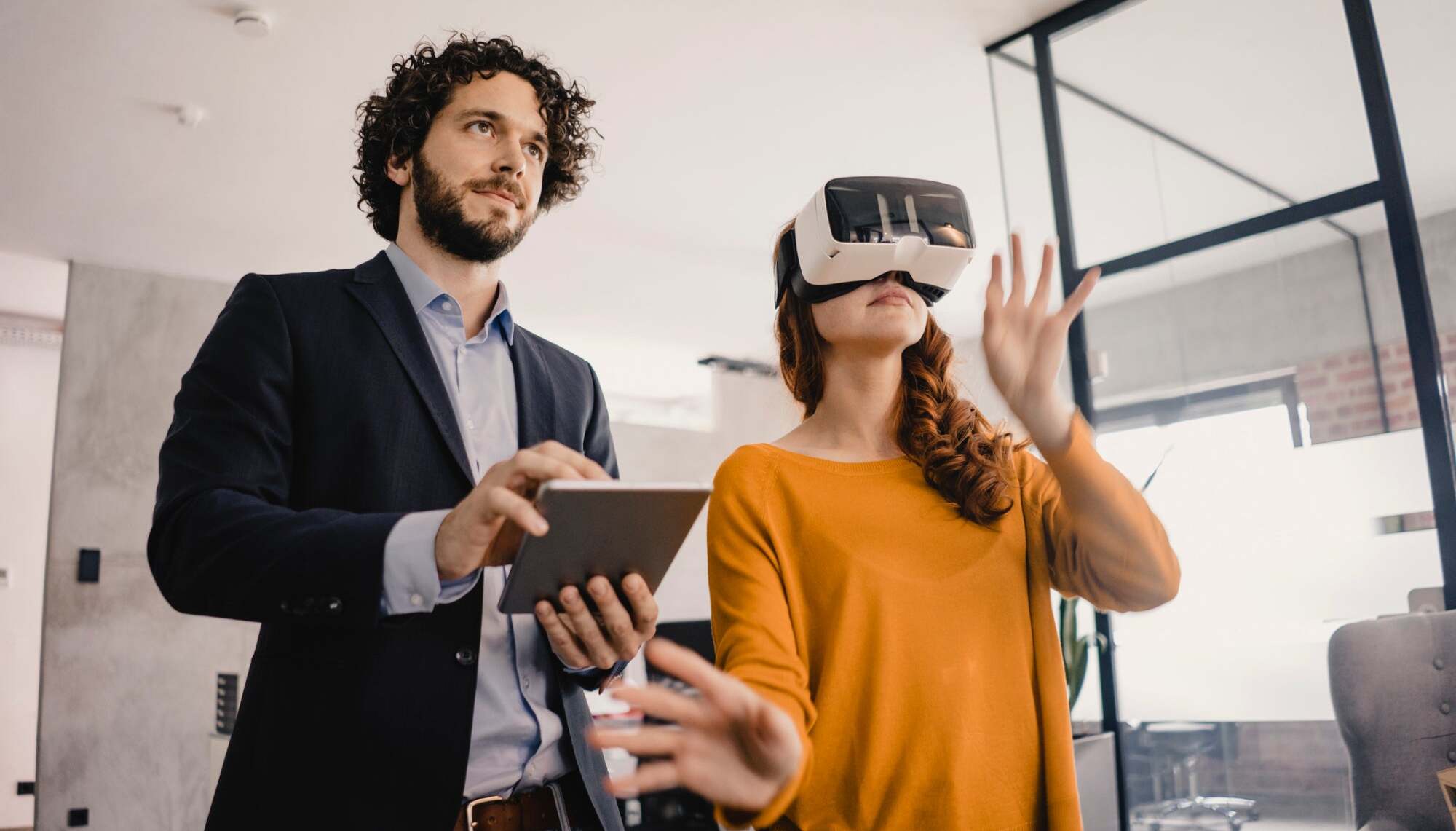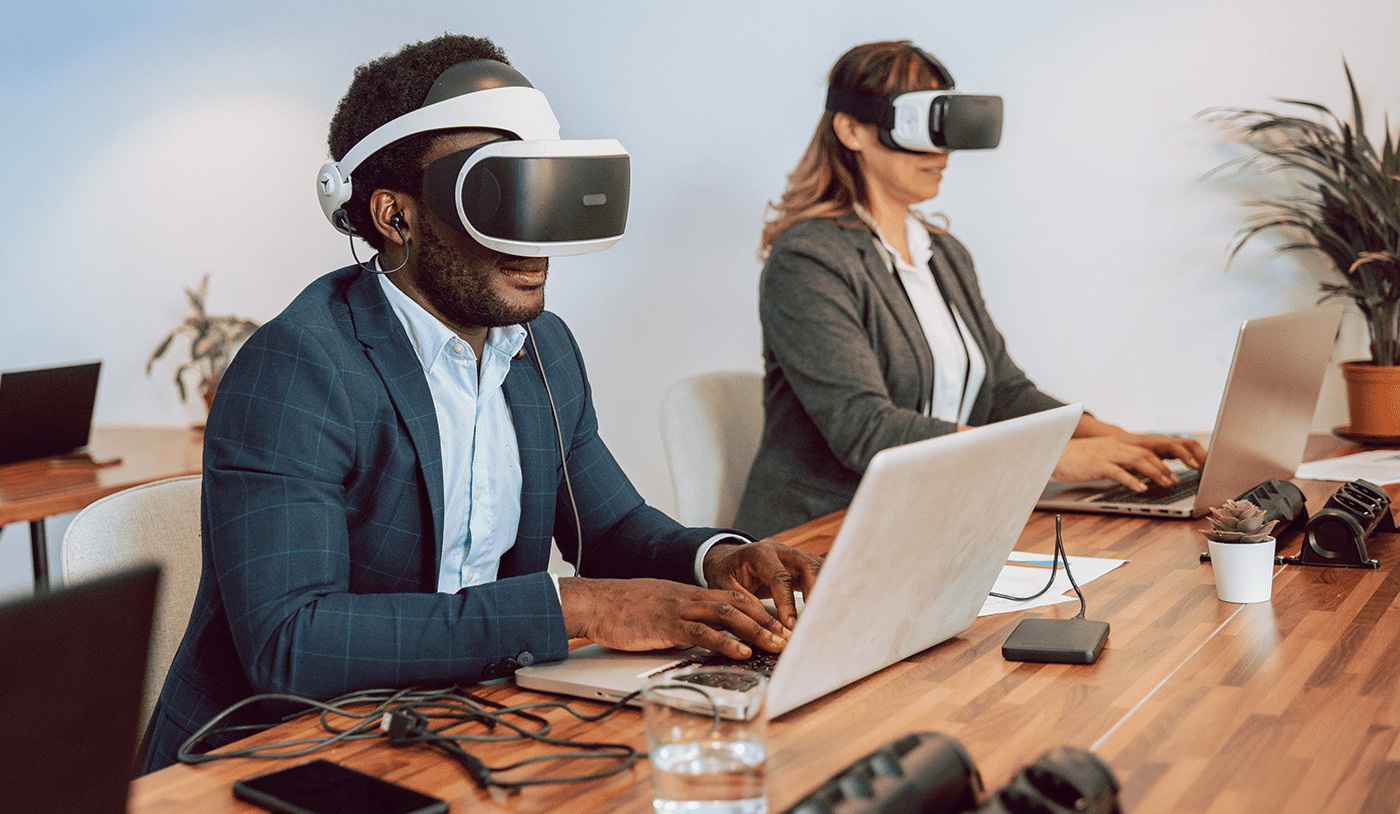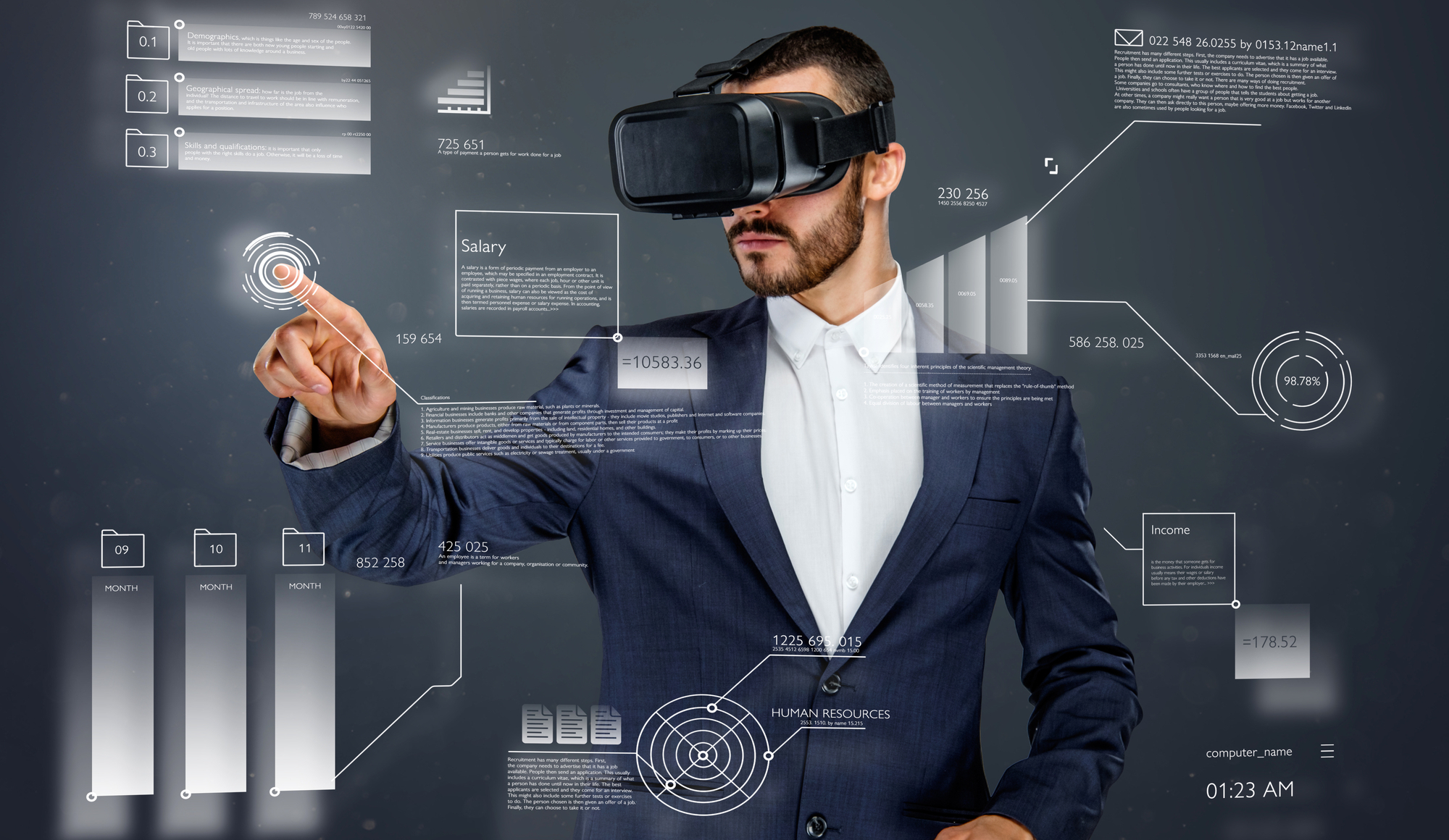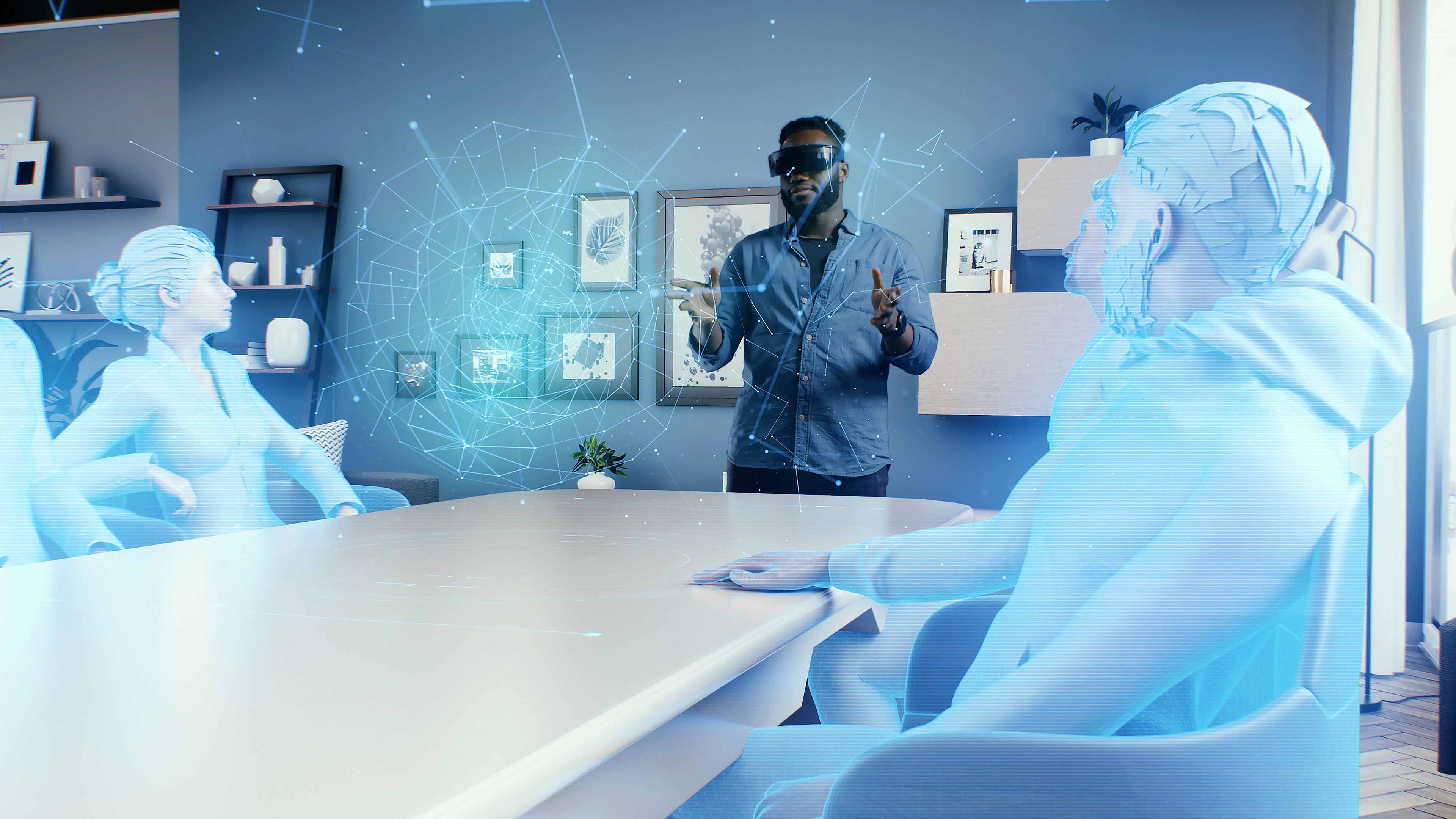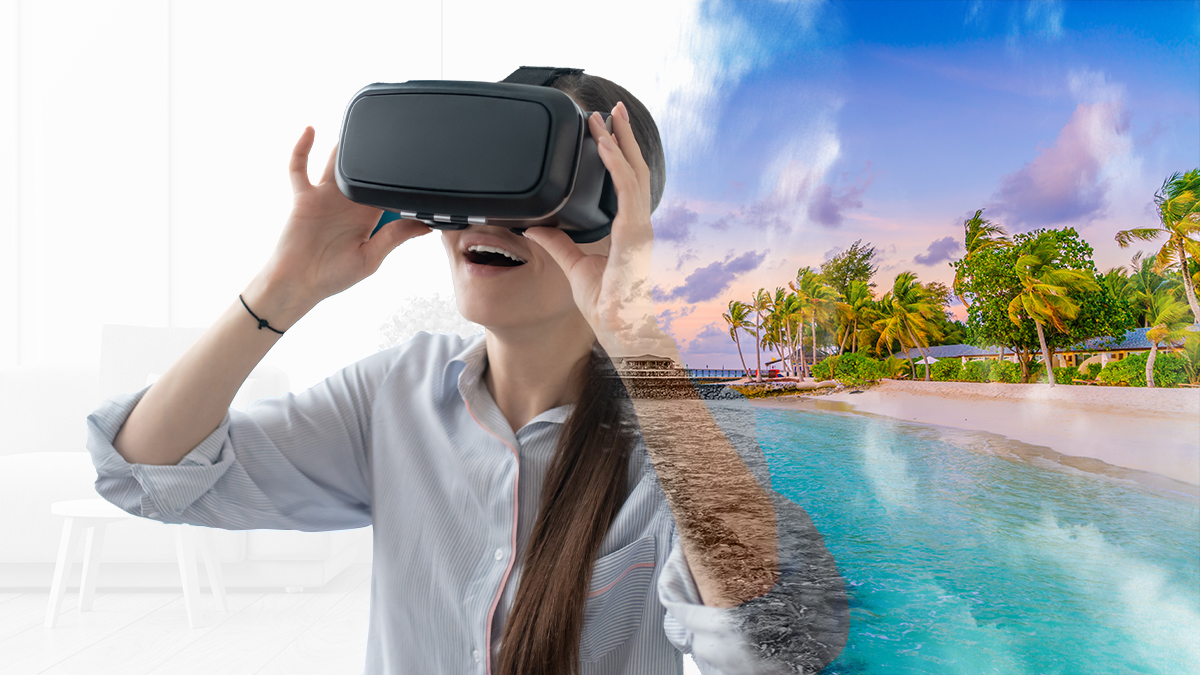Overview
Virtual reality (VR) technology has rapidly expanded its presence in various industries, including business training. It offers a unique and immersive experience that traditional training methods cannot match. With the ability to create realistic and interactive simulations, VR has revolutionized the way businesses provide training to their employees.
By using VR in business training, companies can engage their employees in a whole new way, enhancing the learning experience and ultimately improving performance. Let’s explore the most important benefits of incorporating virtual reality into business training programs.
Improved Engagement:
One of the major advantages of VR in business training is the increased level of engagement it provides. Traditional training methods often fail to captivate learners, leading to reduced attention and retention. However, with VR, trainees are fully immersed in a simulated environment, which encourages active participation and attentiveness. This heightened engagement leads to a greater understanding and application of the training material.
Enhanced Learning Experience:
VR enables a highly interactive and dynamic learning experience. Trainees can actively participate in simulated scenarios, making decisions and solving problems in real-time. This hands-on approach allows for practical application and deepens the understanding of concepts. Learners can also repeat simulations to reinforce their knowledge and gain confidence in applying it in real-world situations.
Cost-effective Training:
Implementing traditional training methods often incurs high costs, such as travel expenses, venue rentals, and materials. In contrast, VR-based training can significantly reduce these costs. With VR, trainees can access virtual environments from anywhere, eliminating the need for physical training locations. Additionally, VR training programs can be easily updated and scaled without incurring additional expenses, making it a cost-effective solution for businesses.
Risk-free Environment:
In certain industries, such as healthcare and aviation, training in a real-world setting can be risky or even life-threatening. VR provides a safe and controlled learning environment where trainees can practice skills and procedures without any actual consequences. This allows for valuable experience and preparation in high-stress and high-risk scenarios, ensuring that employees are well-prepared for real-world challenges.
Real-time Feedback:
VR training programs can provide immediate feedback to trainees, allowing them to learn from their mistakes and refine their skills in real-time. This instant feedback loop helps trainees understand their strengths and areas for improvement, enhancing the overall learning process. Trainers can also monitor trainee progress and provide personalized guidance, leading to accelerated skill development.
Improved Engagement
One of the significant advantages of using virtual reality (VR) in business training is the improved level of engagement it offers. Traditional training methods often struggle to captivate learners, resulting in reduced attention and knowledge retention. However, VR technology provides a unique and immersive experience that actively involves trainees in the learning process, leading to enhanced engagement and better outcomes.
When employees participate in VR-based training, they are fully immersed in realistic and interactive simulations. This immersive environment creates a sense of presence, making them feel like they are experiencing real-life scenarios. As a result, trainees become more focused and attentive, increasing their level of engagement with the training material.
Moreover, VR allows for interactive participation, enabling trainees to actively engage with the content. Instead of passively listening to lectures or watching demonstrations, employees can actively interact with virtual objects, perform tasks, and make decisions within the simulated environment. This hands-on approach not only enhances engagement but also facilitates deeper learning and understanding of the subject matter.
Furthermore, VR offers a multi-sensory experience that stimulates both visual and auditory senses. Trainees can see and hear the virtual environment around them, creating a more realistic and engaging experience. This sensory immersion further reinforces the sense of presence and captivates the learners’ attention, ensuring that they remain engaged throughout the training session.
Research has shown that improved engagement leads to better knowledge retention. When trainees are actively engaged in the learning process, they are more likely to remember and apply the information taught in the training program. VR-based training enhances retention by providing a memorable and impactful experience that connects theoretical knowledge with practical application.
Additionally, the immersive nature of VR training eliminates distractions and external interruptions. Trainees can isolate themselves from the outside world and focus solely on the training content, allowing for a more immersive and focused learning experience. This reduced cognitive load and enhanced attention result in improved engagement and better knowledge absorption.
Overall, VR-based training significantly improves engagement by creating an immersive, interactive, and multi-sensory learning experience. By actively involving trainees and minimizing distractions, VR ensures that employees remain engaged and attentive, leading to better knowledge retention and enhanced learning outcomes.
Enhanced Learning Experience
Virtual reality (VR) technology offers a unique and innovative approach to business training, creating an enhanced learning experience for employees. Unlike traditional training methods, which often rely on lectures and theoretical knowledge, VR provides a highly interactive and dynamic learning environment that promotes active learning and practical application.
VR-based training allows employees to actively participate in simulated scenarios, where they can make decisions, solve problems, and apply their knowledge in real-time. This hands-on approach enables trainees to learn through experience, reinforcing their understanding of concepts and enhancing their problem-solving skills. By actively engaging with the training content, employees develop a deeper level of comprehension and gain confidence in their abilities.
In VR training, employees can repeat simulations multiple times, allowing for continuous practice and reinforcement of learning. This repetitive exposure to scenarios improves retention and helps trainees build muscle memory, enabling them to perform tasks with accuracy and efficiency. The ability to repeat simulations also allows employees to learn from their mistakes and refine their expertise, leading to a more comprehensive learning experience.
Moreover, VR training programs can simulate a wide range of environments and situations, providing trainees with exposure to scenarios that may be difficult or costly to recreate in real life. For example, healthcare professionals can practice complex medical procedures, and construction workers can experience high-risk scenarios without any actual consequences. This realistic and immersive training experience prepares employees for real-world challenges and equips them with the skills necessary to handle various situations.
Another aspect that enhances the learning experience in VR training is the use of feedback mechanisms. Trainees receive immediate and personalized feedback based on their performance within the virtual environment. This real-time feedback helps individuals identify their strengths and areas for improvement, allowing for targeted skill development. Trainers can also track trainee progress and provide additional guidance when needed, ensuring continuous learning and improvement.
Furthermore, VR facilitates collaborative learning experiences. Employees can engage in team-based simulations, where they can work together to solve problems and complete tasks. This collaborative aspect promotes communication, cooperation, and problem-solving skills, replicating real-world work environments. By engaging in group activities and discussions within the virtual space, employees develop essential teamwork skills that can be applied in their day-to-day work.
Overall, VR technology enhances the learning experience by promoting active participation, practical application, repetitive practice, exposure to diverse scenarios, personalized feedback, and collaborative learning. This holistic approach to training ensures that employees not only gain theoretical knowledge but also develop the practical skills and confidence needed to excel in their roles.
Cost-effective Training
Virtual reality (VR) technology has revolutionized business training by offering a cost-effective alternative to traditional training methods. Implementing conventional training approaches often comes with significant expenses, such as travel costs, venue rentals, and materials. However, VR-based training programs can significantly reduce these expenses while providing an immersive and engaging learning experience.
One of the primary cost-saving benefits of VR training is the elimination of travel-related expenses. With VR, trainees can access virtual environments from anywhere, eliminating the need for physical travel to training locations. This remote accessibility not only saves money on transportation costs but also reduces the time and logistical challenges associated with coordinating in-person training sessions.
Additionally, the scalability of VR training programs allows businesses to train a large number of employees simultaneously. Instead of conducting separate training sessions for each individual or group, virtual training can be delivered to multiple participants at once, in the comfort of their own locations. This scalability reduces the need for hiring additional trainers or renting larger training venues, resulting in significant cost savings.
Furthermore, VR-based training eliminates the need for physical training materials such as printed manuals, workbooks, and supplies. All the necessary information and resources can be accessed digitally within the virtual environment, reducing printing and distribution costs. This also enables easy updates and revisions to the training content, ensuring that employees always have access to the latest information without the need for reprinting materials.
Maintenance costs are also minimized in VR training. Physical training equipment and facilities require regular maintenance, repairs, and replacements. With VR, there is no need for the same level of maintenance as physical equipment, as everything exists in the virtual realm. This reduces ongoing expenses and ensures that training programs remain accessible and functional over time.
Moreover, VR training programs can be reused and shared across multiple locations and departments within a company. Once a VR training module is developed, it can be easily replicated and distributed to different teams or branches, resulting in significant cost savings. This reusability and portability of training content make VR an efficient and cost-effective solution for businesses with multiple locations or divisions.
Overall, VR-based training provides a cost-effective alternative to traditional training methods. By eliminating travel expenses, reducing the need for physical materials, enabling scalability, lowering maintenance costs, and allowing for content reusability, VR training offers significant cost savings without compromising the quality and effectiveness of the learning experience.
Risk-free Environment
Virtual reality (VR) technology offers a unique advantage in business training by providing a safe and controlled learning environment. In certain industries, such as healthcare, aviation, and manufacturing, training in real-world settings can pose significant risks to both trainees and individuals involved. By utilizing VR, businesses can create simulations that replicate realistic scenarios without subjecting trainees to any actual dangers, ensuring a risk-free training experience.
One of the main benefits of using VR in training is the ability to simulate high-stress and high-risk situations. For example, surgeons can practice complex surgeries without the risk of harming real patients, pilots can engage in flight simulations without the risk of accidents, and firefighters can train for hazardous scenarios without the risk of injury. By immersing trainees in these simulated environments, businesses can provide hands-on training while eliminating the potential for harm or costly mistakes.
VR allows trainees to practice and refine their skills in a controlled setting, away from the pressures and consequences of real-world situations. This creates a space for employees to make mistakes, learn from them, and build confidence in their abilities. Trainees can repeat simulations as many times as needed to perfect their techniques and decision-making processes, ensuring that they are well-prepared for real-world challenges.
Another advantage of a risk-free VR environment is the opportunity for trainees to explore scenarios that are rare or infrequently encountered in their everyday work. In industries where certain events or emergencies are uncommon, it can be challenging to provide real-life exposure to trainees. VR training bridges this gap by allowing employees to experience and practice rare or complex situations, ensuring they are prepared to handle them if they arise.
VR also provides a safe platform for employees to experiment with new ideas or approaches without fear of negative consequences. Trainees can test different strategies, make decisions, and observe the outcomes within the virtual environment, enabling them to learn from their actions in a risk-free setting. This fosters innovation, creativity, and adaptability among employees, as they can explore different possibilities without the fear of detrimental outcomes.
Furthermore, VR-based training can simulate hazardous environments, such as chemical spills, structural failures, or natural disasters, where real-world training would pose significant risks. Employees can learn how to respond and handle these dangerous situations safely, without endangering themselves or others. This ensures that they are well-prepared to handle emergencies effectively, minimizing the potential for harm and damage in real-life scenarios.
Overall, VR offers a risk-free environment for employees to practice and refine their skills in high-risk and high-stress situations, without the associated dangers. By providing a safe platform for experimentation and exposure to rare scenarios, VR training ensures that employees are well-prepared, confident, and competent when facing real-world challenges.
Real-time Feedback
Real-time feedback is a crucial component of effective business training, and virtual reality (VR) technology excels in providing immediate and personalized feedback to trainees. Unlike traditional training methods, where feedback may be delayed or generalized, VR-based training allows for real-time feedback that enhances the learning process and enables trainees to make adjustments and improvements on the spot.
In VR training, trainees receive feedback based on their performance within the virtual environment. Whether they are practicing a specific skill, completing a task, or making decisions, the VR system can analyze their actions and provide instant feedback on their performance. This feedback can come in various forms, such as visual cues, audio prompts, or haptic feedback, depending on the type of training simulation.
The immediate feedback loop in VR training allows trainees to understand the impact of their actions and make corrections in real-time. If they encounter challenges or errors, they can learn from their mistakes and adjust their approach without the fear of negative consequences. This iterative process of receiving feedback and making adjustments facilitates faster skill development and enhances the overall learning experience.
Additionally, the feedback provided in VR training can be personalized to each trainee’s needs. The VR system can track individual progress, identify areas for improvement, and deliver specific feedback tailored to each trainee’s performance. This personalized feedback enables trainees to focus on their individual strengths and weaknesses, ensuring a more targeted and efficient learning experience.
Trainers and instructors also play a crucial role in providing real-time feedback during VR training. They can monitor trainee progress remotely using data analytics and performance metrics provided by the VR system. With this information, trainers can intervene, offer guidance, and provide additional support when necessary, further enhancing the learning process. This combination of automated and human feedback creates a comprehensive and personalized training experience for each individual.
Moreover, the real-time feedback in VR training allows for immediate celebration and recognition of trainees’ achievements. When trainees reach milestones, successfully complete tasks, or demonstrate improvement, the VR system can provide positive reinforcement, such as virtual rewards or acknowledgments. This instant recognition motivates trainees, boosts their confidence, and reinforces positive learning behaviors.
Overall, real-time feedback in VR training enhances the learning process by providing immediate and personalized feedback to trainees. The ability to make corrections in real-time, personalized guidance from trainers, and the opportunity for immediate celebration of achievements all contribute to a more effective and engaging learning experience.
Remote Collaboration
Virtual reality (VR) technology offers a unique advantage in business training by enabling remote collaboration among geographically dispersed teams. With the rise of remote work and virtual teams, VR-based training provides a platform for employees to collaborate, communicate, and learn together, regardless of their physical location.
In a virtual reality training setting, employees can interact and collaborate in a shared virtual environment. This means that team members located in different cities or even different countries can come together in the same virtual space, allowing for seamless collaboration and knowledge sharing. VR technology creates a sense of presence and proximity, making it feel like all participants are physically present in the same location.
With VR-based training, remote teams can engage in collaborative activities, such as group exercises, problem-solving simulations, or team-based projects. Employees can work together to solve complex tasks, share insights and expertise, and learn from each other’s experiences. This collaborative approach promotes teamwork, communication, and cooperation within the virtual environment, mirroring real-world work dynamics.
Furthermore, VR allows for real-time communication and interaction among team members. Trainees can use voice chat or text messaging functionalities within the virtual environment to communicate with each other, ask questions, and exchange ideas. This fosters a sense of connection, encourages active participation, and ensures that everyone is on the same page during training sessions.
Another benefit of remote collaboration in VR training is the ability to bring together diverse perspectives and expertise. By breaking down physical barriers, employees from different departments, teams, or locations can participate in the same training program. This diversity in experience and knowledge enhances problem-solving capabilities, promotes innovation, and encourages cross-functional collaboration.
In addition to collaboration during training sessions, VR technology also facilitates post-training discussions and debriefing sessions. After completing a simulation or exercise, team members can come together virtually to reflect on their experiences, share lessons learned, and discuss ways to apply their newly acquired knowledge in their respective roles. This post-training collaboration promotes continuous learning, knowledge sharing, and application of skills in a collective and collaborative manner.
Moreover, remote collaboration in VR training extends beyond scheduled training sessions. Employees can also access the virtual training platform at their own convenience and continue learning at their own pace. This asynchronous learning allows individuals to engage in collaborative activities, share resources, and communicate asynchronously, catering to flexible work schedules and time zone differences.
Overall, VR-based training promotes remote collaboration by bringing together geographically dispersed teams in a shared virtual environment. This enables seamless communication, fosters teamwork and cooperation, encourages knowledge sharing, and facilitates the exchange of diverse perspectives. Leveraging VR technology for remote collaboration in business training enhances the overall learning experience and contributes to the development of cohesive and high-performing virtual teams.
Scalability and Consistency
One of the significant advantages of incorporating virtual reality (VR) technology into business training is the scalability and consistency it offers. VR-based training programs can be easily scaled to accommodate large numbers of participants while ensuring a consistent and standardized learning experience across the board.
Traditional training methods often face challenges when it comes to scalability. Limited physical space, instructor availability, and resource constraints can make it difficult to provide training to a large number of employees simultaneously. However, with VR training, scalability becomes much more feasible. Since trainees can access the training program remotely, multiple individuals or teams can undergo the training simultaneously, without the need for physical space limitations or logistical constraints. This scalability allows businesses to train large cohorts of employees efficiently and cost-effectively.
Moreover, VR-based training ensures consistency in the delivery of training content. In traditional training environments, variations in instructor capabilities, teaching styles, and knowledge levels can result in inconsistent learning experiences. However, with VR, the training program can be standardized and delivered consistently to all participants, regardless of location or time. This consistency ensures that every employee receives the same high-quality training, eliminating potential discrepancies and knowledge gaps.
Consistency also extends to the content itself. With VR training, businesses can develop standardized modules and simulations that are replicated and delivered uniformly to all trainees. This ensures that every participant receives the same level of exposure and practice with the training material, leading to a consistent and cohesive learning experience. Additionally, VR training modules can be easily updated and modified, ensuring that training content remains relevant and up-to-date.
Scalability and consistency go hand in hand in VR training. The scalable nature of VR allows businesses to provide consistent training experiences to a large number of participants, without compromising quality or effectiveness. Whether training a small team or a global workforce, VR ensures that the same training curriculum and content are delivered uniformly to all employees.
Furthermore, VR technology provides the ability to track and monitor trainee progress consistently. Trainers and administrators can access data and analytics from the VR system to evaluate trainee performance, identify areas for improvement, and provide targeted feedback. This data-based approach enables consistent monitoring and evaluation of trainee progress, ensuring that training objectives are met and skills are developed consistently across the organization.
Overall, the scalability and consistency of VR-based training make it an ideal solution for businesses looking to train a large number of employees while maintaining a standardized learning experience. The uniformity of content delivery, the ability to easily scale training programs, and the consistent monitoring of trainee progress all contribute to effective and efficient training outcomes.
Diversity and Inclusivity
Virtual reality (VR) technology has the power to promote diversity and inclusivity in business training. By creating immersive and inclusive training environments, VR training programs allow individuals from diverse backgrounds to participate and learn in a safe and equal space, fostering a sense of belonging and promoting understanding and empathy.
One of the key benefits of VR training is its ability to simulate diverse scenarios and environments. Businesses can create training simulations that reflect real-world diversity, allowing employees to gain exposure to different cultures, perspectives, and experiences. By immersing trainees in these diverse environments, VR training promotes cultural sensitivity, empathy, and inclusivity, enabling employees to better understand and work effectively with individuals from different backgrounds.
VR training also provides a platform for individuals with different physical abilities to participate equally. The virtual environment can be customized to accommodate various accessibility needs, ensuring that everyone can engage in training activities regardless of their physical limitations. This inclusivity enables employees with disabilities to actively participate in training programs, contribute their unique perspectives, and enhance overall team collaboration and effectiveness.
In addition, VR training breaks down geographical barriers and enables remote teams or employees in different locations to participate in the same training program simultaneously. This inclusivity brings together individuals who may have limited access to in-person training opportunities due to their location or other factors. By ensuring equal access to training resources, VR technology enables a diverse range of employees to develop their skills and knowledge on an equal footing.
Furthermore, VR training can empower individuals who may be introverted or have social anxiety by providing a safe and controlled learning environment. These individuals can practice and refine their skills in virtual scenarios, allowing them to build confidence and overcome any barriers they may face in real-life situations. VR training promotes inclusivity by creating an environment that empowers all employees to participate and succeed, regardless of their personality traits or social preferences.
Moreover, VR training allows for customized and personalized learning experiences that cater to individual preferences and learning styles. Trainees can engage with training content at their own pace, revisit modules or simulations as needed, and focus on the areas that require more attention. This adaptability ensures that employees have equal opportunities to learn and grow, regardless of their unique learning needs and preferences.
By embracing VR technology in training, businesses can foster a culture of diversity and inclusivity. Through immersive simulations, accessibility accommodations, remote collaboration, empowering environments, and personalized learning experiences, VR training promotes understanding, empathy, and equal opportunities for all employees.
Mindset Shift
Virtual reality (VR) technology has the potential to induce a significant mindset shift in business training. By immersing trainees in realistic and interactive virtual environments, VR training can challenge traditional modes of thinking, stimulate creativity, foster a growth mindset, and promote a willingness to embrace change and innovation.
One of the ways VR training facilitates a mindset shift is by creating simulations that replicate real-world challenges and scenarios. Trainees can actively engage with these simulations, making decisions and facing consequences based on their actions. This experiential learning approach encourages trainees to adopt a problem-solving mindset, think critically, and develop the ability to adapt to different situations.
Moreover, VR training exposes employees to scenarios that may be outside of their comfort zones. By pushing trainees to address challenging and unfamiliar situations, VR training encourages them to step outside their comfort zones and overcome barriers. This helps individuals develop resilience, adaptability, and a mindset that embraces new challenges rather than avoiding them.
Virtual reality can also play a role in breaking down mental barriers and biases. VR training allows individuals to experience situations from different perspectives, fostering empathy and understanding. By challenging preconceived notions and biases, VR can help employees develop a more inclusive and open-minded mindset, leading to increased collaboration and creativity in the workplace.
Furthermore, VR training can enhance creativity and innovation by providing a playground for experimentation and idea generation. Within the virtual environment, trainees can test new approaches, explore creative solutions, and experiment without the fear of real-world consequences. This freedom to explore and innovate fosters a mindset that values experimentation, embraces failure as a learning opportunity, and ultimately drives innovation in the workplace.
Another aspect of mindset shift in VR training is the sense of self-efficacy it fosters. By allowing trainees to actively engage with challenging scenarios and providing real-time feedback, VR training builds confidence and self-belief. Trainees recognize their ability to navigate difficult situations and develop a mindset that embraces continuous learning and growth.
Additionally, VR training can change the mindset around traditional training methods. Trainees who have experienced the immersive and interactive nature of VR may find traditional lecture-style training less engaging and effective. This shift in mindset can lead to a demand for more interactive and experiential training approaches, pushing organizations to explore new and innovative training methods that better align with the needs and expectations of today’s learners.
In summary, VR training has the potential to induce a powerful mindset shift in employees. By exposing individuals to realistic challenges, fostering adaptability, breaking down barriers and biases, nurturing creativity and innovation, building self-efficacy, and challenging traditional training approaches, VR can transform how employees approach learning, problem-solving, and embracing change in the workplace.
Conclusion
Virtual reality (VR) technology has revolutionized the landscape of business training, offering a wide range of benefits that traditional training methods cannot match. Through improved engagement, enhanced learning experiences, cost-effectiveness, risk-free environments, real-time feedback, remote collaboration, scalability and consistency, diversity and inclusivity, and mindset shift, VR training has transformed how businesses approach employee development.
The immersive and interactive nature of VR training significantly boosts trainee engagement, resulting in higher retention and application of knowledge. By providing a multi-sensory experience and creating realistic simulations, VR enhances the learning process and enables practical application of skills in a controlled environment.
VR training also offers cost-effective solutions by eliminating travel expenses, reducing the need for physical training materials, accommodating scalability, and ensuring consistency in content delivery. With its remote collaboration capabilities, VR enables geographically dispersed teams to collaborate effectively, fostering communication, cooperation, and cross-cultural understanding.
Moreover, VR training creates a risk-free environment, allowing employees to experiment, learn from their mistakes, and effectively handle high-stress and high-risk scenarios. The real-time feedback provided in VR training enables trainees to make immediate adjustments and improvements, while personalized guidance from instructors ensures continuous learning and skill development.
By fostering diversity and inclusivity, VR training brings together individuals from different backgrounds, abilities, and locations. It promotes cultural sensitivity, empathy, and equitable opportunities for learning and growth, creating an inclusive training environment.
Lastly, VR training facilitates a mindset shift by challenging traditional thinking, promoting problem-solving skills, embracing change and innovation, fostering resilience, and empowering employees to step outside their comfort zones.
Overall, leveraging VR technology in business training yields numerous advantages that enhance the learning experience, promote collaboration, and drive overall performance. As the use of VR continues to expand, businesses that embrace this technology can stay at the forefront of employee development and create a workforce that is well-equipped to thrive in an ever-evolving business landscape.







